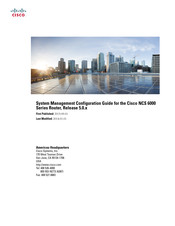Cisco NCS 6000 Series Router Manuals
Manuals and User Guides for Cisco NCS 6000 Series Router. We have 3 Cisco NCS 6000 Series Router manuals available for free PDF download: Configuration Manual, Manual
Cisco NCS 6000 Series Configuration Manual (498 pages)
IOS XR Release 6.4.x
Brand: Cisco
|
Category: Network Router
|
Size: 6.69 MB
Table of Contents
Advertisement
Cisco NCS 6000 Series Configuration Manual (117 pages)
System Management Configuration Guide, Release 5.0.x
Brand: Cisco
|
Category: Network Router
|
Size: 2.94 MB
Table of Contents
Cisco NCS 6000 Series Manual (12 pages)
Brand: Cisco
|
Category: Network Router
|
Size: 1.38 MB
Table of Contents
Advertisement


